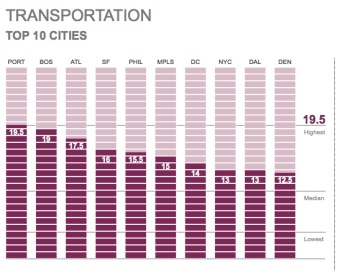The City of Portland has earned a #2 ranking in the first-ever “City Energy Efficiency Scorecard” released yesterday by the American Council For An Energy-Efficient Economy (ACEEE). We came in behind Boston, but ahead of major cities like San Francisco, New York and Seattle (a total of 34 cities were included in the study).
The scorecard ranked each city in five separate categories: local government, community, buildings, utilities, and transportation. Portland placed #1 in the local government and transportation categories. That’s not a big surprise given that we have more daily bicycle commuters than any other major American city (and a growing number of low-car residents).
Here are the “Best Practices” the ACEEE listed in the Transportation category:
- Ensure zoning and construction regulations encourage the development of bike, transit, and pedestrian-friendly neighborhoods and commercial areas to help reduce miles traveled by car.
- Coordinate transportation and land use planning to improve access to energy-efficient transportation options, and provide additional options such as car and bike sharing.
- Increase service levels and funding available for public transit.
- Provide incentives for purchasing efficient vehicles, encourage fuel-saving driving habits, and improve electric vehicle charging infrastructure.
- Encourage greater use of efficient methods for transporting goods, such as rail and water.
Portland Mayor Charlie Hales pointed out that this strong showing comes on the heels of our designation from the United Nations as the “Number 1 Green City in North America.” In a press release, Hales said, “From 1990 to today, our population grew from about 440,000 to about 600,000. But our carbon emissions over that same time fell by about 28 percent. We’re pretty proud of that.”
Asked specifically how bicycling figures into the city’s energy footprint, Mayor Hales said via email, “We’re taking a one-size-doesn’t-fit-all approach. It’s biking and walking. It, bus and light rail and streetcar. It’s smart urban design, with livable, walking neighborhoods. It’s even paving, because good roads are a factor in increasing fuel efficiency for cars. We can’t be satisfied with any one approach. And we’re not.”
Check out the full infographic and see how other cities stacked up in each category on the ACEEE website.


